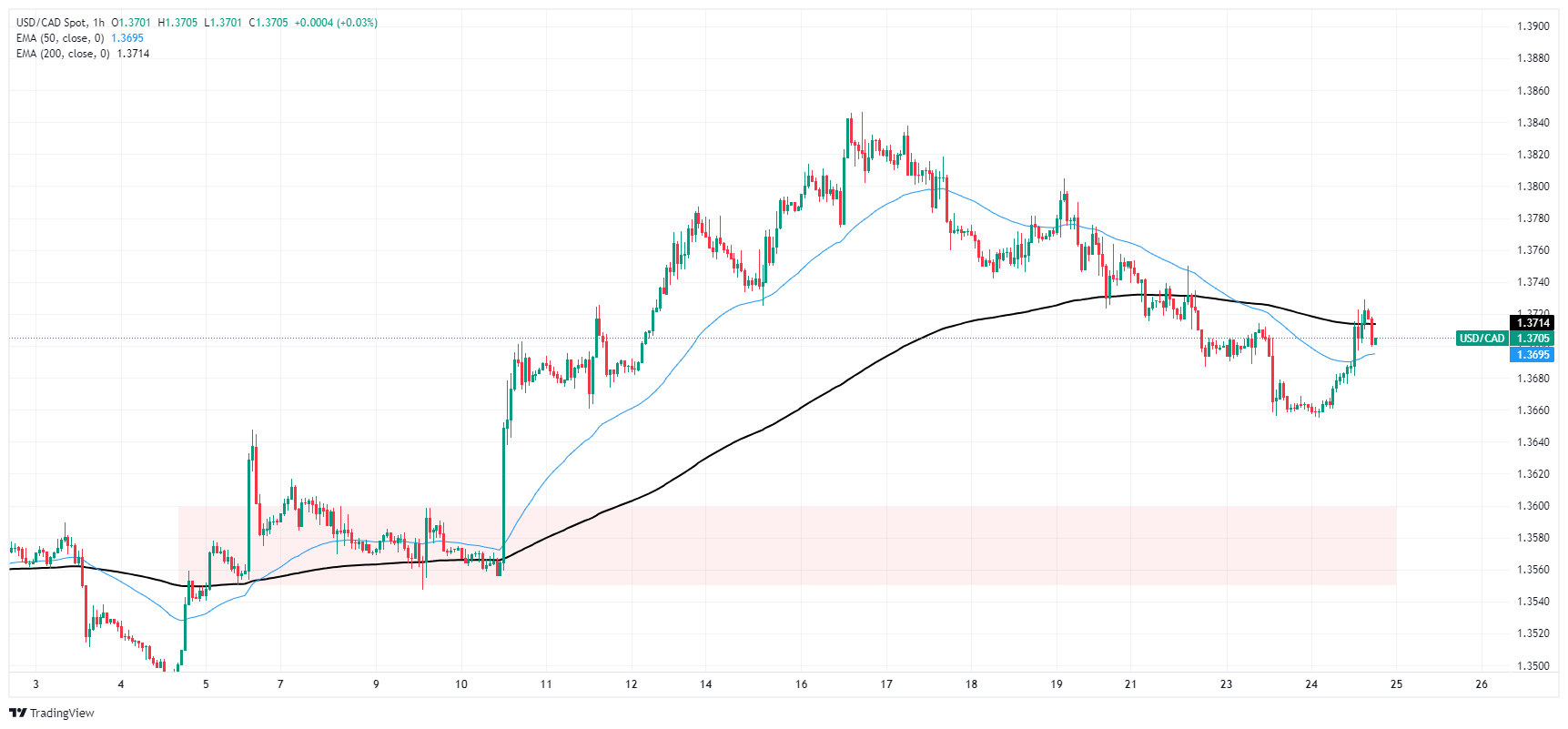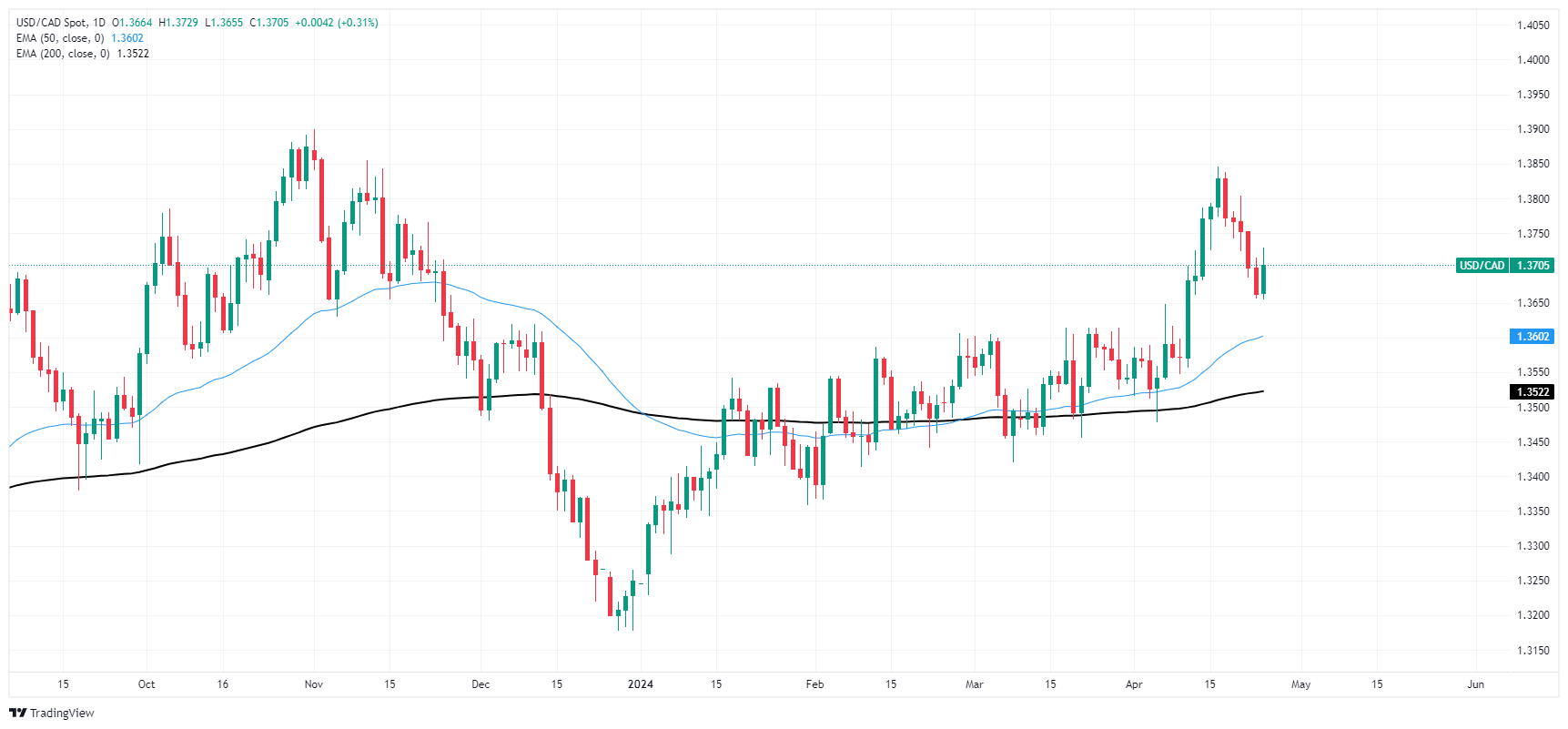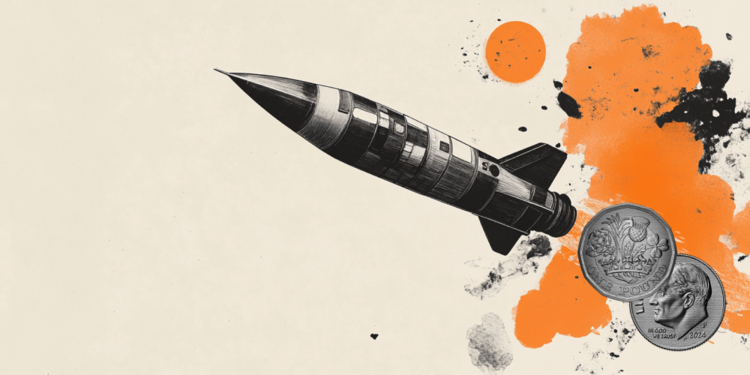- The Canadian dollar declines overall on Wednesday.
- Canadian retail sales missed targets, hurting the Canadian dollar.
- US GDP and PCE inflation will dominate the second half of the week.
The Canadian Dollar (CAD) loses ground on Wednesday, paring recent gains and retreating against most major currencies, making it one of the worst-performing currencies in the mid-week session. Canadian retail sales derailed forecasts, falling in February and sending the CAD reeling.
Canada is absent from the economic calendar for the rest of the week, and investors will focus on key data from the US. Gross Domestic Product (GDP) and Personal Consumption Price Index (PCE) will be released on Thursday and Friday, respectively.
Daily Market Moves Summary: Canadian Dollar Trims Gains After Drop in Canadian Data
- On a monthly basis, Canadian retail sales fell -0.1% in February, an improvement from the previous month's -0.3% decline, but falling short of the expected 0.1% rebound.
- Non-auto retail sales also fell -0.3%, versus 0.0% expected. The January figure was revised slightly downward, from 0.5% to 0.4%.
- The US Dollar's rally in markets is putting further pressure on the CAD as investors rethink Tuesday's broad rally in risk appetite.
- First-quarter US GDP on Thursday is expected to come in at 2.5% annualized, down from 3.4% previously.
- Traders expect Friday's US PCE price index to remain at 0.3% in March.
- Financial markets, desperate at the prospect of the US Federal Reserve (Fed) cutting interest rates, are becoming increasingly frustrated by persistent inflation in the US economy. Friday's numbers will generate a lot of volatility as markets grapple with forecasts of rate cuts.
Price of the Canadian Dollar today
Below is the percentage change of the Canadian Dollar (CAD) against the main currencies. The Canadian Dollar was the strongest currency against the Japanese Yen.
| USD | EUR | GBP | CAD | AUD | JPY | NZD | CHF | |
| USD | 0.06% | -0.01% | 0.30% | -0.15% | 0.34% | 0.04% | 0.25% | |
| EUR | -0.04% | -0.08% | 0.25% | -0.18% | 0.27% | -0.01% | 0.15% | |
| GBP | 0.01% | 0.08% | 0.33% | -0.11% | 0.34% | 0.07% | 0.25% | |
| CAD | -0.30% | -0.26% | -0.33% | -0.44% | 0.01% | -0.26% | -0.09% | |
| AUD | 0.15% | 0.18% | 0.11% | 0.43% | 0.43% | 0.18% | 0.36% | |
| JPY | -0.34% | -0.30% | -0.36% | 0.00% | -0.46% | -0.23% | -0.10% | |
| NZD | -0.03% | 0.02% | -0.07% | 0.25% | -0.19% | 0.28% | 0.18% | |
| CHF | -0.23% | -0.15% | -0.25% | 0.09% | -0.36% | 0.12% | -0.17% |
The heat map shows the percentage changes of the major currencies against each other. The base currency is chosen in the left column, while the quote currency is chosen in the top row. For example, if you choose the Euro in the left column and scroll down the horizontal line to the Japanese Yen, the percentage change that appears in the box will represent EUR (base)/JPY (quote).
Technical Analysis: Canadian Dollar Falls Overall, USD/CAD Retraces Key Technical Levels
The Canadian Dollar (CAD) fell by a third against the US Dollar (USD) and the British Pound (GBP) on Wednesday, but a weak Japanese Yen (JPY) competes with the CAD for last place.
The USD/CAD pair has broken back above the 1.3700 area, testing chart territory north of the 200 hourly EMA near 1.3715. The pair bounced off the 1.3660 level to cut Tuesday's declines.
Wednesday's pullback sent USD/CAD into its first day in the green after five consecutive days of losses. The pair continues to decline from the last high at 1.3850, and the long-term technical support of the 200-day EMA lies near the 1.3500 zone at 1.3522.
USD/CAD hourly chart
USD/CAD daily chart
Frequently Asked Questions about the Canadian Dollar
What factors determine the price of the Canadian dollar?
The key factors that determine the price of the Canadian dollar (CAD) are the level of interest rates set by the Bank of Canada (BoC), the price of oil, Canada's main export product, the health of its economy, inflation and the trade balance, which is the difference between the value of Canadian exports and its imports. Other factors are market confidence, that is, whether investors bet on riskier assets (risk-on) or look for safe assets (risk-off), with the risk-on being positive for the CAD. As its largest trading partner, the health of the US economy is also a key factor influencing the Canadian dollar.
How do Bank of Canada decisions affect the Canadian dollar?
The Bank of Canada (BoC) exerts significant influence over the Canadian Dollar by setting the level of interest rates that banks can lend to each other. This influences the level of interest rates for everyone. The BoC's main objective is to keep inflation between 1% and 3% by adjusting interest rates up or down. Relatively high interest rates are usually positive for the CAD. The Bank of Canada can also use quantitative easing and tightening to influence credit conditions, with the former being negative for the CAD and the latter being positive for the CAD.
How does the price of oil affect the Canadian dollar?
The price of oil is a key factor influencing the value of the Canadian Dollar. Oil is Canada's largest export, so the price of oil tends to have an immediate impact on the value of the CAD. Generally, if the price of oil rises, the CAD also rises, as aggregate demand for the currency increases. The opposite occurs if the price of oil falls. Higher oil prices also tend to lead to a higher probability of a positive trade balance, which also supports the CAD.
How does inflation data influence the value of the Canadian Dollar?
Although inflation has traditionally always been considered a negative factor for a currency, as it reduces the value of money, the opposite has actually happened in modern times, with the relaxation of cross-border capital controls. Higher inflation often leads central banks to raise interest rates, attracting more capital inflows from global investors looking for a lucrative place to store their money. This increases the demand for the local currency, which in the case of Canada is the Canadian Dollar.
How does economic data influence the value of the Canadian dollar?
The published macroeconomic data measures the health of the economy and may have an impact on the Canadian dollar. Indicators such as GDP, manufacturing and services PMIs, employment and consumer confidence surveys can influence the direction of the CAD. A strong economy is good for the Canadian dollar. Not only does it attract more foreign investment, but it may encourage the Bank of Canada to raise interest rates, resulting in a stronger currency. However, if economic data is weak, the CAD is likely to fall.
Source: Fx Street
I am Joshua Winder, a senior-level journalist and editor at World Stock Market. I specialize in covering news related to the stock market and economic trends. With more than 8 years of experience in this field, I have become an expert in financial reporting.







